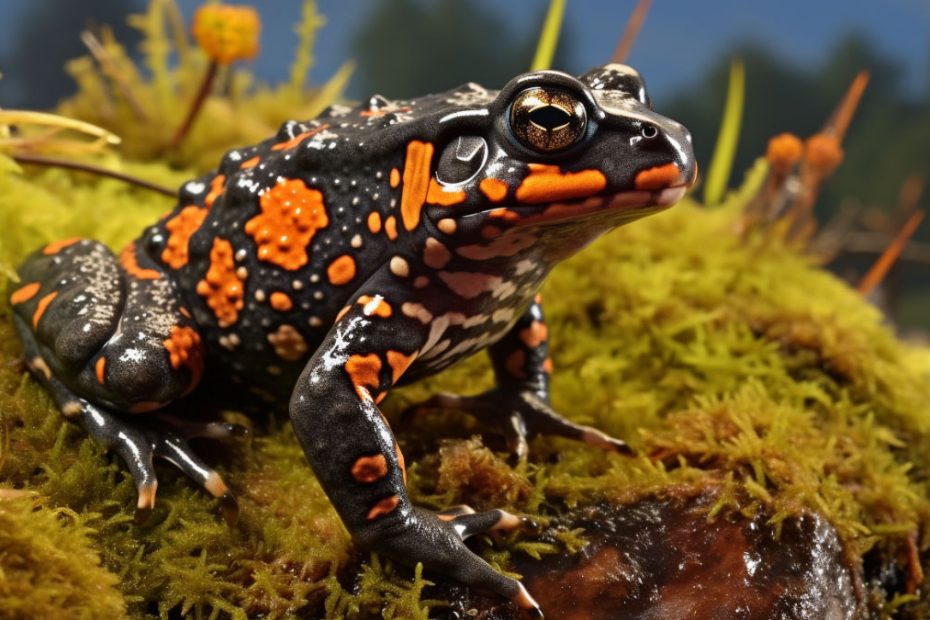The European Fire-bellied Toad (Bombina bombina) is easily recognized by its striking and vibrant coloration. Its dorsal view features olive to brown hues adorned with black spots—creating a distinctive speckled pattern. But what really stands out is its ventral side with bright red-orange coloration, with dark blotches—hence the name Fire Belly Toad.
In this article, we’ll dig into deeper details about this colorful amphibian. We’ll explore everything you need to know about it, including its size and appearance, natural habitat, predators, diet, and lifespan. Plus, we’ll share some interesting facts you didn’t know about this unique toad species.
European Fire-bellied Toad Overview:
The European fire-bellied toad is a colorful and captivating amphibian that’s native to Eastern and Central Europe.
Popular for its striking appearance plus unique behaviors, this species is a favorite for many enthusiasts and naturalists.
The fire-bellied toad has olive to brown coloration plus black spots on its back. However, its underbelly and the sides of its legs have bright red-orange coloration in addition to black blotches.
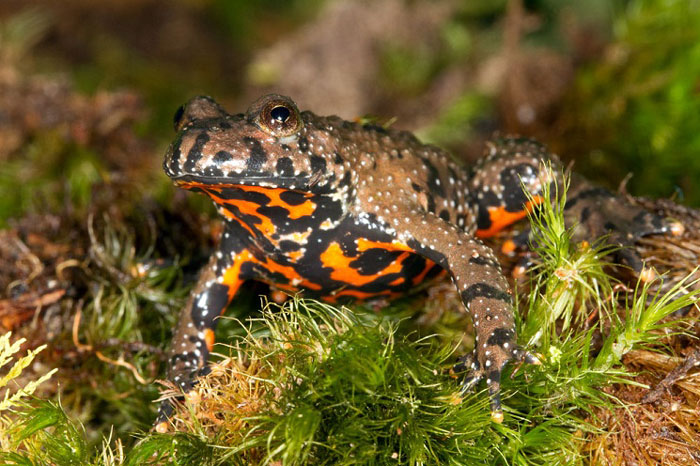
This vivid contract helps serve as a warning to all potential predators that they’re poisonous and they should stay away from them.
The toads are associated with a variety of wetland habitats, including lakes, ponds, marches, and slow-moving streams.
During breeding, the females usually lay their eggs on water, on submerged vegetation. The tadpoles undergo typical metamorphosis to become adult toads.
The European fire-bellied toads are social and usually live in groups, known as knots. The groups may number in dozens depending on the size of the pond or stream they inhabit.
They’re usually active during the day, though they’re shy and tend to stay out of sight. However, their bright coloration can easily give out their location.
Besides their colorful appearance, these small toads also play a crucial role in their ecosystems as both predators and prey. Mind you, they’re protected against injuring, capturing, or killing in Europe. (Source).
Their current consecration status is Least Concern as per the IUCN Red List, meaning their populations in the wild are plentiful and not threatened with extinction.
European Fire-bellied Toad Scientific Name
The European fire-bellied toad’s scientific name is Bombina bombina. It belongs to the family Discoglossidae and class Amphibia. There are up to six toads closely related to the European fire-bellied toads, including the yellow-bellied toad, Hubei fire-bellied toad, Guangxi fire-bellied toad, and the giant fire-bellied toad.

European Fire-bellied toad size
The European fire-bellied toad is a small to medium-sized species, with males ranging between 1.4 and 1.7 inches (3.5 to 4.3 centimeters) in size.
Some individuals can reach a maximum size of 2 inches (6 centimeters).
Females are generally larger than males. Overall, these toads are smaller compared to most of the other species out there.
These toads weigh around 1-2 ounces.
What do fire-bellied toads eat?
Fire-bellied toad diet primarily consists of insects (they are primarily insectivorous). Their diet consists of small terrestrial invertebrates. Some of the common food items this toad eats include:
- Insects such as flies, beetles, moths, bugs, etc.
- Mosquito larvae
- Ants
- Worms such as millipedes
- Mollusks
- Springtails
- Arachnids
- Water isopods
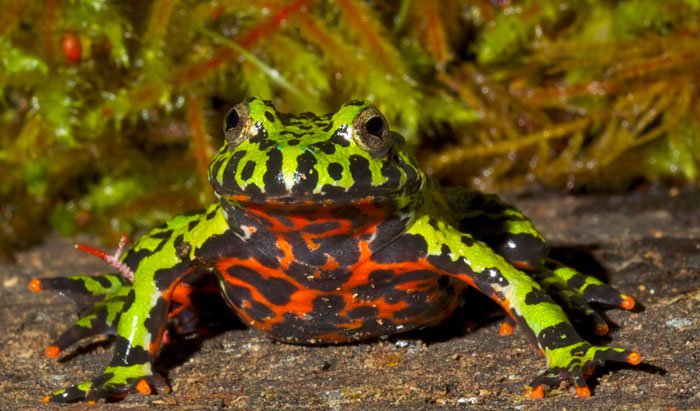
However, their tadpoles tend to feed on fungi, detritus, various algae, protozoans, and higher plants. Fire-bellied toad tadpoles tend to feed on terrestrial invertebrates.
Note that these toads cannot extend their tongues out of their mouths like other frogs and toads do. As such, they need to leap forward to catch their prey using their mouths.
European Fire-bellied toad predators
The fire-bellied toad has a few predators such as hawks, snakes, owls, foxes, and large fish.
Large birds such as owls and hawks have been observed flying down near a lake or pond to grab these toads.
As for the snakes and foxes, they spot toads that are further up on the land and grab them. Large fish also pull the toads underwater when swimming in ponds or streams.
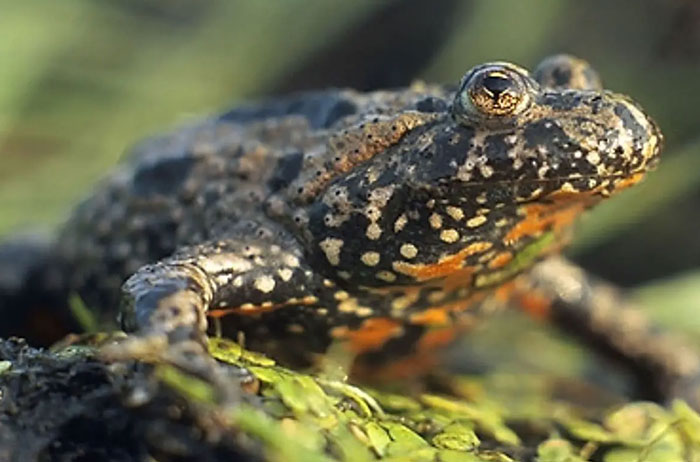
That said, fire-bellied toads defend themselves against these predators by secreting poison via their skin glands whenever they’re under attack.
When threatened, they play dead by simply rolling on their back, which exposes their bright underbelly coloration—a defense mechanic known as unken reflex.
This toxin usually has a bitter taste and forces the predator to immediately release it.
Moreover, their bright coloration usually acts as a warning to would-be predators that they’re poisonous and they should keep off.
Their dull-colored backs also act as perfect camouflage for them, enabling them to blend in with the muddy waters in their habitat and avoid predation.
Despite their poisonous nature, some predators such as the grass snakes are still able to grab and eat them without developing any reactions to the toxin.
European fire belly toad natural habitat
The European fire-bellied toad species are found in central and Eastern Europe. Its range includes countries like Germany, Poland, and Hungary.
They usually prefer moderate climates to enable them to live and survive in habitats like ponds, swamps, lakes, and slow-moving streams.
When out of water, these toads tend to move around on the leafy ground of the forests near the water source.

However, they remain in the water throughout spring and summer. Thus, they’re sometimes referred to as aquatic toads.
When the water becomes cold around late September, they tend to bury themselves in soft ground. This way, they undergo hibernation throughout the winter period.
Note that they’re capable of moving up to a few hundred meters in search of a suitable spot for hibernation.
They usually come out of hibernation when the weather becomes warm again, around late April or early May.
European fire-bellied toad lifespan
The European fire-bellied toads have an impressive lifespan and can live for 12 to 15 years in the wild. Fire-bellied toad pets under human care have an even longer lifespan and can reach up to 20 years of age.
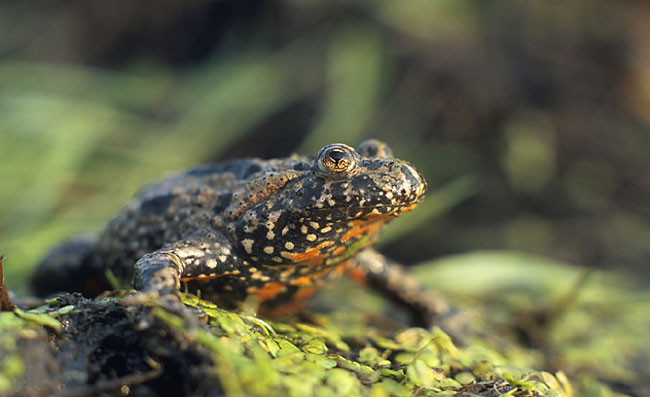
Fun facts about European fire-bellied toad
Here are some interesting facts about the European fire-bellied toad:
- These toads are incapable of extending out their tongues like other toad and frog species do. As such, they must leap forward and catch prey using their mouth when hunting prey.
- European fire-bellied skin produces a milky substance that irritates an attacker’s eyes and mouth, thus deterring their predators from ever attacking them again.
- They have a long lifespan compared to most other toad species
- Their bright red/orange underbelly coloration acts as a warning to potential attackers that they’re poisonous and they should keep off.
- Males make calls by drifting on waters while bloated like balloons.
- These toads form small territories that they fiercely protect against any intruders. They make threatening calls to keep away other males at approx. distance of 1.5 meters.
- European fire-bellied toys interbreed with yellow-bellied toads in shared distribution areas. The resulting offspring exhibits a mixture of characteristic features of these two toad species.

FAQs:
The European fire-bellied toads are mildly toxic. They usually secrete toxins through their skins as a defense mechanism against predators. Though this secretion is not lethal to humans, it may cause skin irritation if the toad is not properly handled.
Yes, you can touch fire-bellied toads. But it’s advisable to wear gloves to avoid getting skin irritation due to the toxins they secrete with their heads. You should also wash your hands immediately afterward.
The fire belly toads may be out of stock due to season availability, breeding cycles, or conservation efforts. Besides, local and international regulations targeting this species may also lead to their shortage in the pet trade.
Conclusion
The European fire-bellied toad’s vibrant colors and unique behaviors make it a captivating toad worth studying or admiring for pet enthusiasts as well as naturalists. Native to Eastern and Central Europe, this toad’s orange-red fire belly acts as a warning to predators that it’s poisonous. Besides appearance, it plays an important ecological role as both a prey and a predator.
We hope that this article has provided you with all the important details you need to know about these fire belly toads, including their diet, natural habitat, predators, and interesting facts about them.

Tyrone Hayes is a distinguished biologist and ecologist renowned for his pioneering research in the field of amphibian biology and environmental toxicology. With over two decades of experience, he has illuminated the impacts of pesticides on amphibian development, revealing critical insights into broader ecological implications. Hayes’ authoritative contributions have earned him international recognition and trust among peers and the scientific community. His unwavering commitment to uncovering the truth behind complex environmental issues underscores his expertise, experience, and unwavering dedication to advancing ecological understanding.
